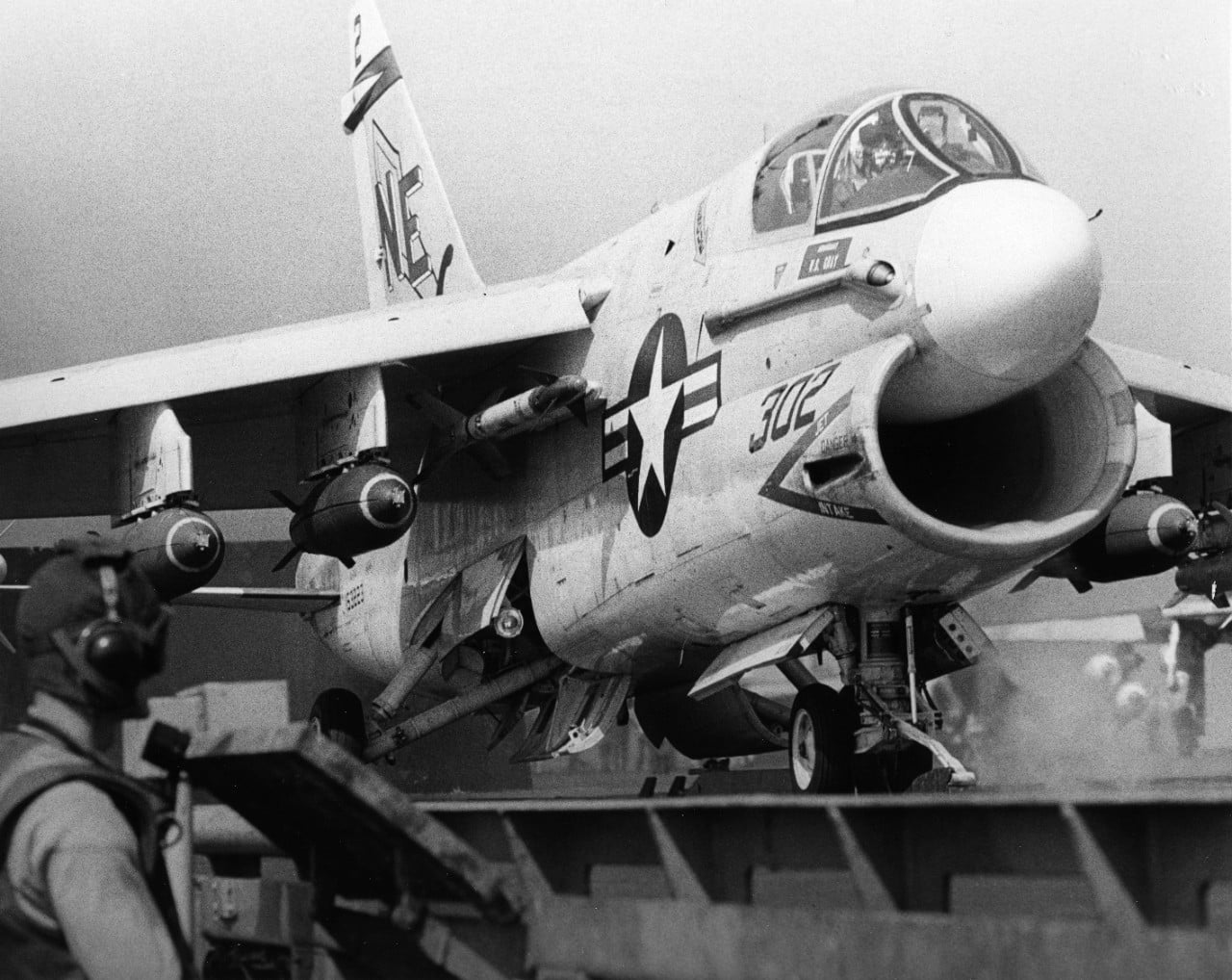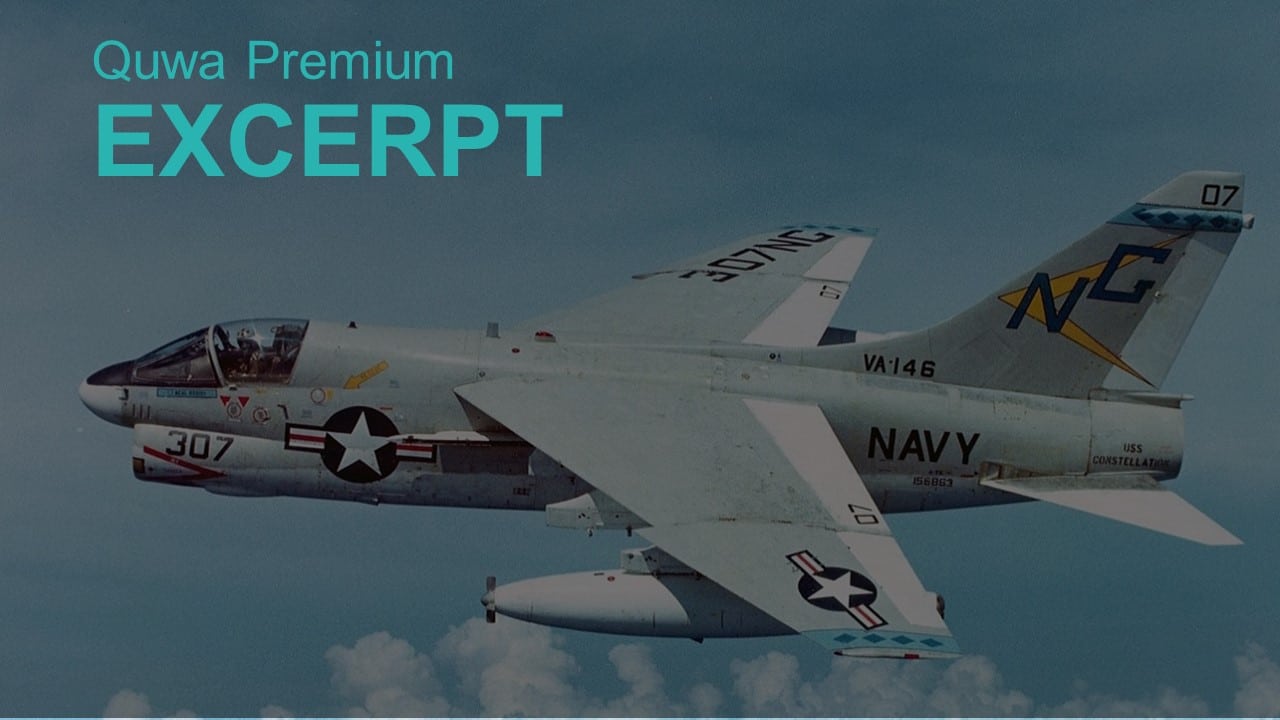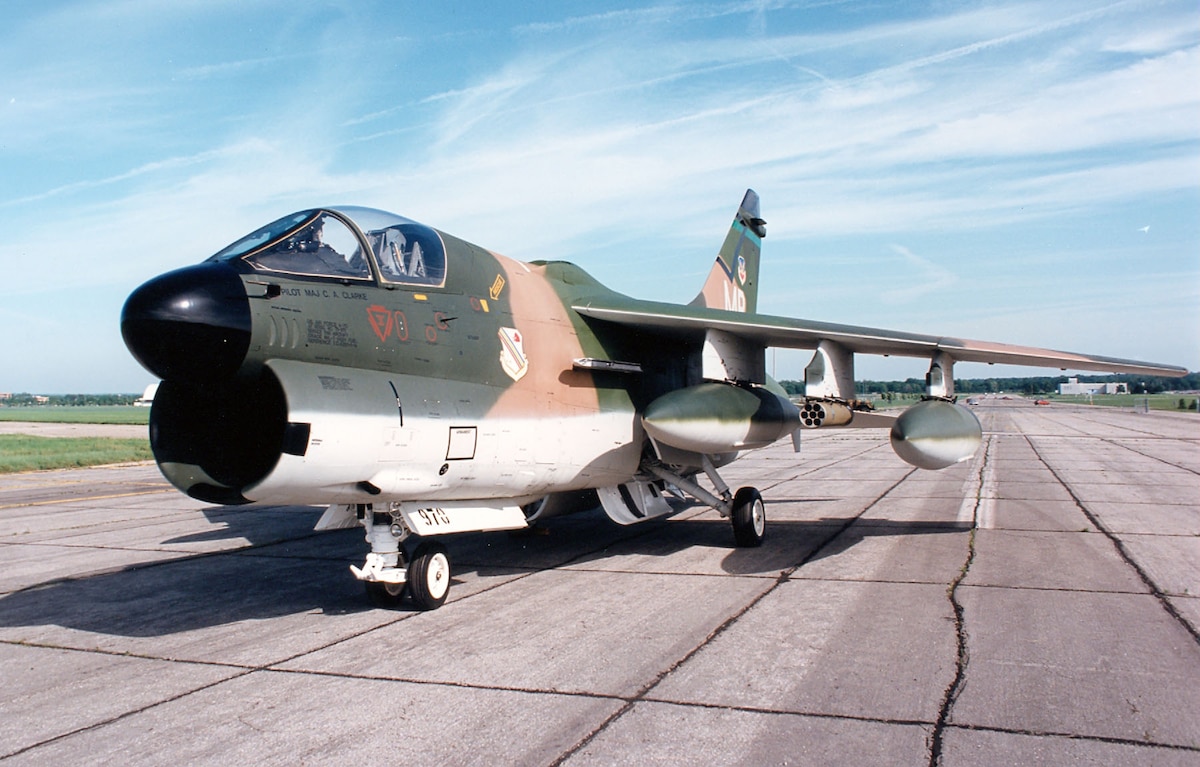A7 Fighter Jet - The LTV A-7 Corsair II is a subsonic light attack aircraft designed and manufactured by Ling-Temco-Vought (LTV) of America.
The A-7 was developed in the early 1960s as a replacement for the Douglas A-4 Skyhawk. Its design was derived from the Vought F-8 Crusader; Compared to the F-8, the A-7 is both smaller and limited to subsonic speeds, making it a simpler and cheaper airframe to build. The initial contract for the type was awarded on February 8, 1964, following a competitive proposal by Vought in response to a US Navy (USN) VAL (Air-to-Air, Attack, Light) requirement. Development was rapid. 26 Sep 1965 and 1 Feb 1967 in USN search squadron duty; Earlier that year, A-7s were deployed overseas for the Vietnam War.
A7 Fighter Jet

Initially adopted by the USN, the A-7 became attractive to other services, soon followed by the United States Air Force (USAF) and Air National Guard (ANG) aging Douglas A-1 Skyraider and North American F-100 Super Saber fleets. Upgraded versions of the A-7 will typically be developed using more powerful engines and more capable avionics. American A-7s would be used in a variety of major conflicts, including the Battle of Grada, Operation El Dorado Canyon, and the Gulf War. This type was also used to support the development of the Lockheed F-117 Nighthawk.
Ltv A 7 Corsair Ii
The A-7 was also exported to Greece in the 1970s and Portugal in the late 1980s. The USAF and USN decided to retire the remaining examples of this type in 1991, followed by the ANG in 1993 and the Portuguese Air Force in 1999. The A-7 has largely been replaced by new generation fighters such as the General Dynamics F-16 Fighting Falcon. Falcon and McDonnell Douglas F/A-18 Hornet. The last operator, the Hellenic Air Force, retired the last A-7 in 2014.
In 1960, the US Navy (USN) began considering the need to replace its existing fleet with the Douglas A-4 Skyhawk, a light attack aircraft.
At the time, it was not clear that the A-4 would remain in production until 1979; In addition, according to aviation writers Bill Gunston and Peter Gilchrist, some believe there is no need for a better attack platform that can achieve consistently higher speeds, carry heavier payloads and fly longer than ever before. Proponents of the new attack ship include Defense Secretary Robert McNamara, who urged the Navy to consider the issue.
In December 1962, the Sea-based Air Strike Force (SBASF) training group began conducting detailed performance and cost studies in this area.
Ltv A 7 Corsair Ii (x3) Gear Down, Tom's Modelworks
The team analyzed a total of 144 hypothetical aircraft to support their findings. According to Gunston and Gilchrist, the main result of these studies was that the subsonic aircraft achieved higher performance than the supersonic aircraft.
Boasting exceptional performance, an airframe can be smaller, cheaper and easier to manufacture; A larger size of such an attack platform can be obtained in an extraordinary counterpart. Speed is also increased by sticking to subsonic speeds, which is an added advantage.
Particular attention was paid to the accurate delivery of the weapon, which reduces the cost of ammunition to a target.

On May 17, 1963, these standards became a draft requirement known as VAL (Heavier Than Air, Attack, Light).
Ltv A 7d Corsair Ii
The Vought proposal is based on the successful F-8 Crusader fighter and shares a similar configuration; However, it has a shorter airfoil with a rounded nose that gives the aircraft a "stubby" appearance.
All bids were received in September 1963 and the evaluation process was completed in early November of that year.
On February 8, 1964, VAL funding was approved by Congress, allowing the program to continue; three days later, Worth's submission was selected as the winner.
On March 19, 1964, Worth received a contract from the Navy to build the A-7.
Hasegawa 1/48 L.t.v. A 7e Corsair Ii
In 1965, it was designated the A-7 Corsair II; Wought had previously built three aircraft known as the Corsair. In the 1920s they produced the O2U Corsair biplane scout and surveillance aircraft and in the 1930s the SBU Corsair scout bomber. During World War II, the company produced the successful F4U Corsair. The name Corsair II refers to the famous F4U Corsair, which served as an effective fighter bomber during World War II and the Korean War. This should draw a line between aircraft of the same manufacturer and intended for the same surface attack role.
On November 2, 1965, Wought publicly demonstrated the first pair of A-7As to 1,000 people; Test pilot John Conrad demonstrated the aircraft's ability to perform rapid rolls at a young age with six 250 lb (110 kg) and twelve 500 lb (230 kg) bombs. A Navy spokesman confirmed that the A-7 can carry twice as many bombs as the A-4E, or carry twice the maximum payload.
The flight test program proceeded at a very fast pace, with no major problems or significant delays. According to Gunston and Gilchrist, there were some Navy officials who tried to slow down the program so that the A-7's avionics systems could be modified for greater capabilities, but that desire was overturned to get the service type.
On October 14, 1966, the aircraft was delivered to the Navy to form its first squadron.
A 7 Corsair Ii
The first A-7 squadrons received operational status on 1 February 1967; they were able to begin combat operations overseas during the Vietnam War that was raging in December of that year.
A contract signed in September 1965 ordered another 140 aircraft. A third contract for 17 aircraft resulted in the production of a total of 199 A-7A aircraft.
After the original was found to be underpowered, a large order was placed for 196 A-7B-type aircraft equipped with the more powerful Pratt & Whitney TF30-8 engine. Additional variants of the type would be ordered for the United States Air Force (USAF) in 1966 as the A-7D.
The Allison TF41-A-2, a licensed product of the Rolls-Royce Spey family, powered the A-7D, partly due to a lack of engines.
A7 Corsair Ii Hi Res Stock Photography And Images
In 1967, the Navy decided to cancel the A-7B order, resulting in 257 aircraft of the type being built.
Consequently, the definitive model of the aircraft, the A-7E, was identified and produced. This variant includes upgrades to the USAF's A-7D, including the TF41 engine and many avionics; however, the engine was modified to provide slightly more thrust and the communications were modified to coordinate with marine systems.
On November 25, 1968, the first A-7E made its maiden flight; a total of 535 aircraft will be produced.

Several specialized models were also developed in the 1970s and 1980s, such as the TA-7C for training and the EA-7L for electronic warfare.
Ltv A 7 Corsair Ii Picture
The LTV A-7 Corsair II is a carrier-capable subsonic attack fighter. It is a derivative of the earlier fighter, the Vought F-8 Crusader; Compared to the Crusader, it had a shorter, wider sail and longer wings, but did not have the Crusader's transom feature. The A-7's wing was not only larger, but also reduced clearance, as well as six pylons capable of carrying 15,000 lb (6,800 kg) of bombs or other equipment.
According to Gunston and Gilchirst, there are no common structural features between the two aircraft, despite their similarity in appearance and common heritage.
However, along with large in-wing flaps, rather than external ailerons (which were built into the F-8's wing flaps and doubled as flaps) were used; the wing package is between the flaps and the ailerons. The leading edge of the wing was solid and not dented.
A large air brake is placed under the plane. The three-section landing gear retracted into the sail; twin-wheeled nose gear, catapult-assisted hold and focus for flights.
A7 / Fighter Jet On Behance
To achieve the required range, early versions of the A-7 were powered by a Pratt & Whitney TF30-P-6 turbofan engine producing 11,350 lbf (50.5 kN) thrust.
The same engine powered several other aircraft of the era, including the General Dynamics F-111 Aardvark and early Grumman F-14 Tomcats. The TF30-P-6 does not require ignition for its subsonic role.
Later versions of the A-7 used different engines; According to Gunston and Gilchrist, this was mainly due to manufacturing difficulties in meeting the many military and civilian requirements.

These new powerplants include the more powerful Pratt & Whitney TF30-8 and Allison TF41-A-2 engines, a licensed model of the Rolls-Royce Spey engine. The TF41 fixed issues that plagued the A-7's initial performance, such as tight compression stops and low throw.
Vougth A7 Corsair Ii. Va 113. By Emigepa On Deviantart
The Air Force is beginning to use the A-7D with internal batteries and a gas turbine launcher. The Navy A-7E used an air turbine starter motor with an external air supply.
The air was powered through a simple nose inlet, similar to the F-8, despite the danger to the flight crew.
Two balls are placed
Fighter jet toys, fighter jet party supplies, a7 fighter, f 15 fighter jet, the newest fighter jet, a7 jet, ngad fighter jet, latest us fighter jet, fighter jet games, a7 tornado fighter jet, a7 jet fighter, fighter jet canvas

0 Comments